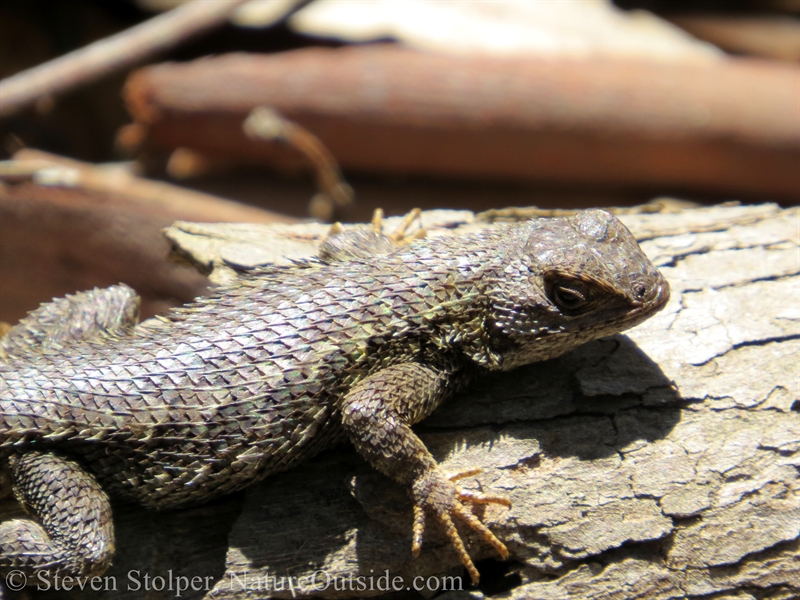
This article contains affiliate links...
What does a Pulitzer Prize winning novelist have to do with lizard poop?
Wallace Stegner was an American novelist, often called “The Dean of Western Writers.” He won the Pulitzer Prize in 1972 for his classic novel, Angle of Repose.
Stegner was also an environmentalist. He’s honored with a stone bench set high in the Santa Cruz Mountains. The bench commands a view of the western slopes of the Santa Cruz Mountains and the Pacific Ocean.
Today it’s my destination for a peaceful breakfast.


I sit on the bench as the morning air slowly warms. In the forest behind me I hear the scratch-scratch of Spotted Towhees foraging in the leaf litter.
I glance idly along the length of the stone bench and notice a pellet slightly larger than a grain of rice. But what catches my attention is that the pellet has a white cap. It sparkles in the sunlight like white lacquer, or more accurately, fresh bird poop.
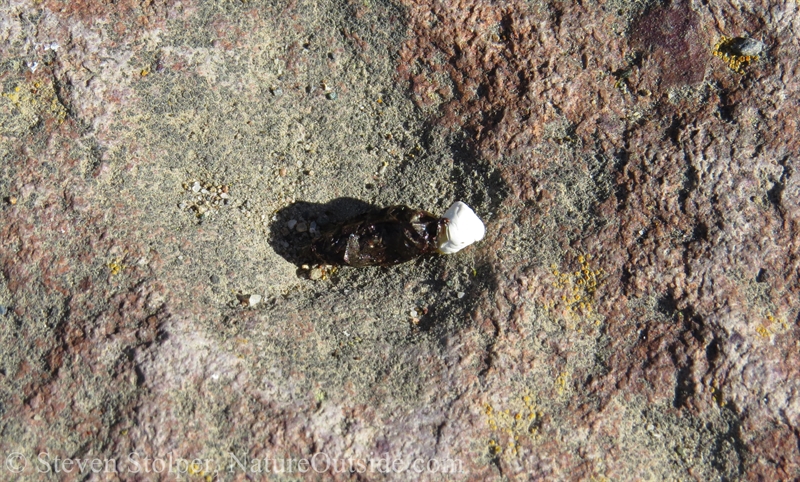
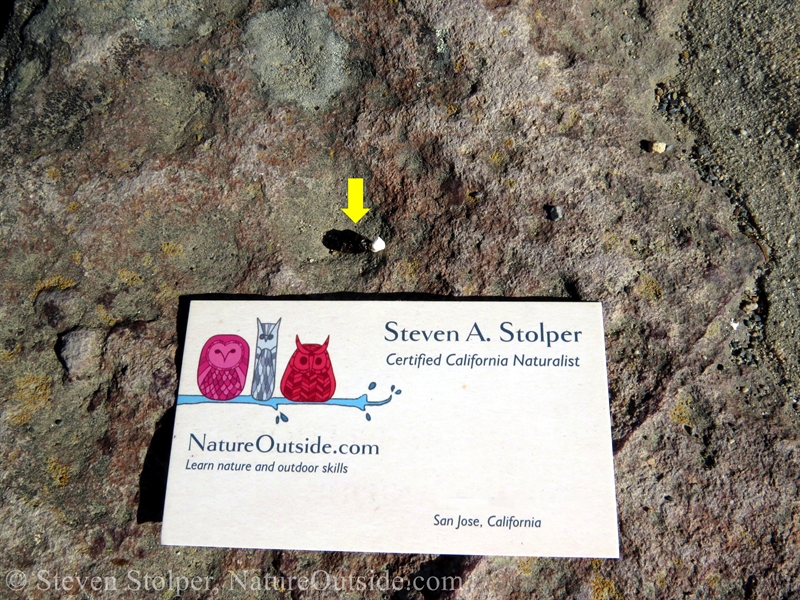
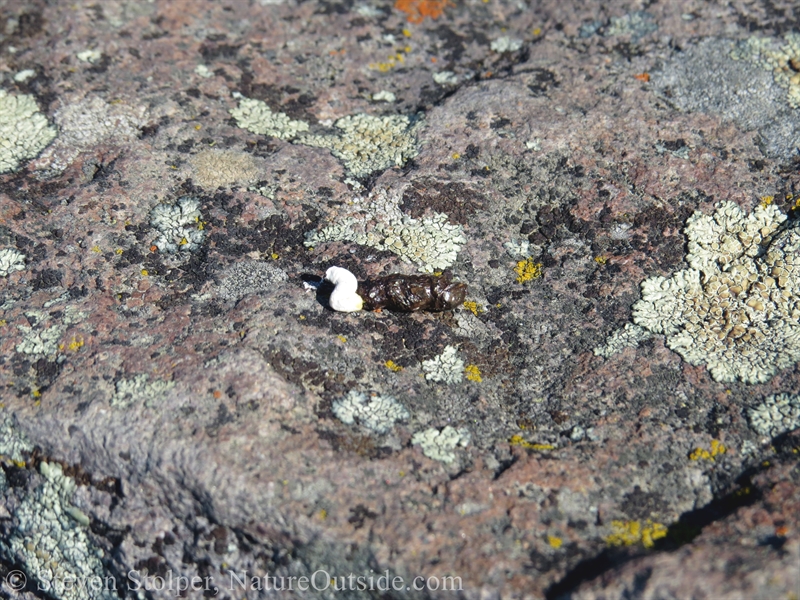
But it’s too small to be bird poop. So it must have come from a small reptile!
Why is Bird Poop White?
Many birds and reptiles hatch from eggs. During their time in the egg, they metabolize and grow. So where do the waste products go?
When the body metabolizes protein, the waste product is toxic ammonia. Humans convert the ammonia to the less toxic urea. Urea is water soluble. And humans have a urinary tract to excrete it with water (urine).
But that’s inconvenient if you live in an egg for any length of time. Can you imagine sharing your egg with toxic urine? Birds, reptiles, and insects solve the problem by creating uric acid instead of urea. It takes more metabolic energy than humans use. But unlike urea, uric acid is not water soluble.
Uric acid is also less toxic than urea. It generally forms a white paste or powder. When you see the white part of a bird splat, that’s uric acid. And in the case of my mystery pellet, it forms the white “cap” I see.
Meet the Western Fence Lizard
The pooping bandit is not hard to find. I see a Western Fence Lizard (Sceloporus occidentalis) hanging out on the back of the bench.
This spiny lizard has keeled scales and is between 2.25 – 3.5 inches from snout to vent. Western Fence Lizards come in a variety of colors from black to brown to gray. I’ve even seen olive ones. They’re usually darker in the morning when they’re cold. Pigment cells in the skin become dark to help the lizard absorb sunlight. The lizards are usually yellow on the rear of their hind limbs. But it’s hard to see this unless you hold one in your hand.

The Western Fence Lizard ranges throughout California and is the best known lizard species in the state. It’s a habitat generalist and thrives in desert, grassland, and forest. The Western Fence Lizard, like its cousin the alligator lizard, helps keep Lyme Disease at bay. The lizard has a chemical in its blood that kills the bacteria that causes Lyme Disease.
The lizards begin each day by basking in an open elevated place. Often they’re displaying the color that gives them their nickname, “blue-bellies.” Males have striking, iridescent blue bellies that they display with a sequence of “pushups” for territorial defense or courtship. Sometimes these crazy lizards displace this warning behavior onto an approaching human!
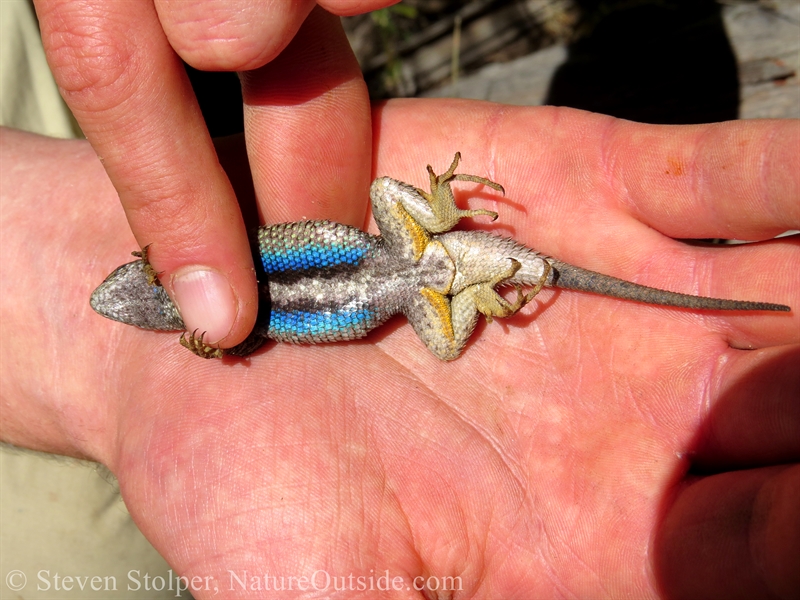
Western Fence Lizards feed on all types of insects. They detect their prey visually and pounce with lightning speed. They eat flies, beetles, ants, grasshoppers, spiders, centipedes, isopods, scorpions, and mites.
Recognizing Lizard Poop
The size and shape of lizard scat usually distinguishes it from bird splats. It is common to find the cap separated from the rest of the feces. So if you see one, look for the other.
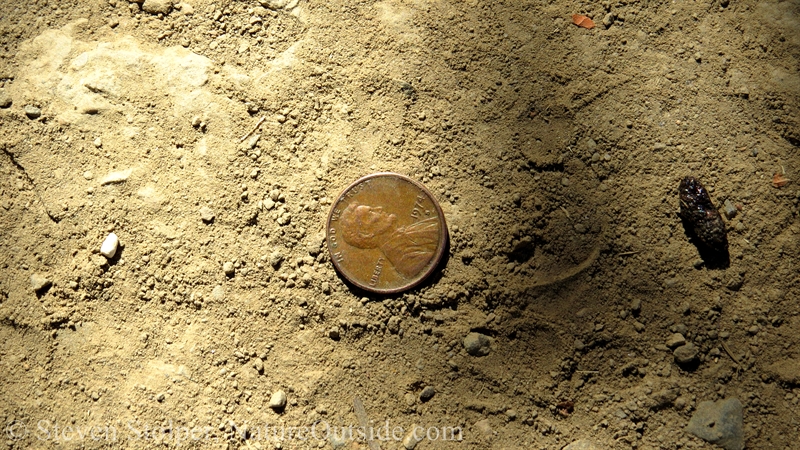
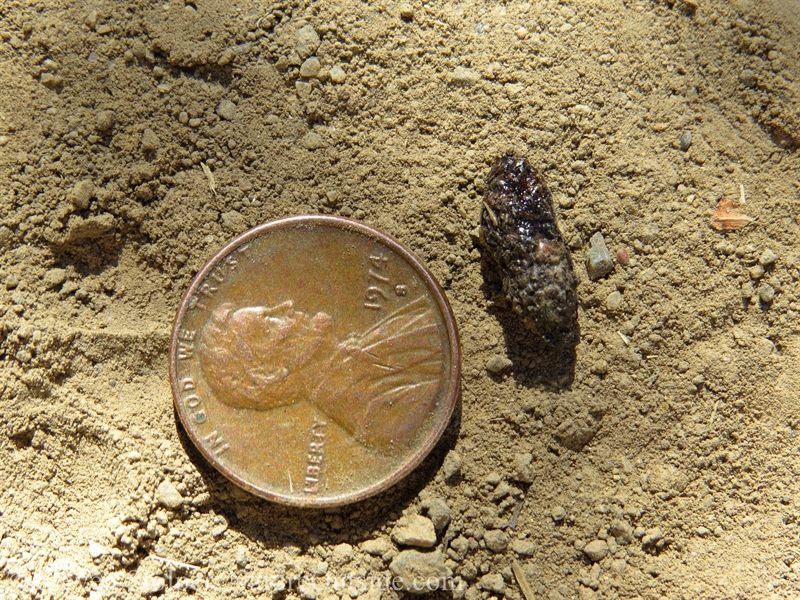
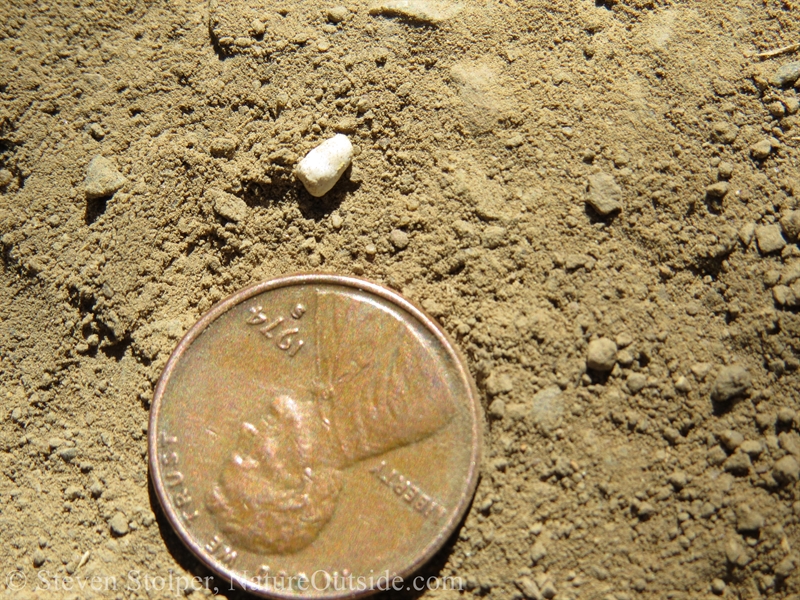
Other Lizard Signs
Another way to locate a Western Fence Lizard is to find a tail drag. On sandy substrate you can find them quite easily.
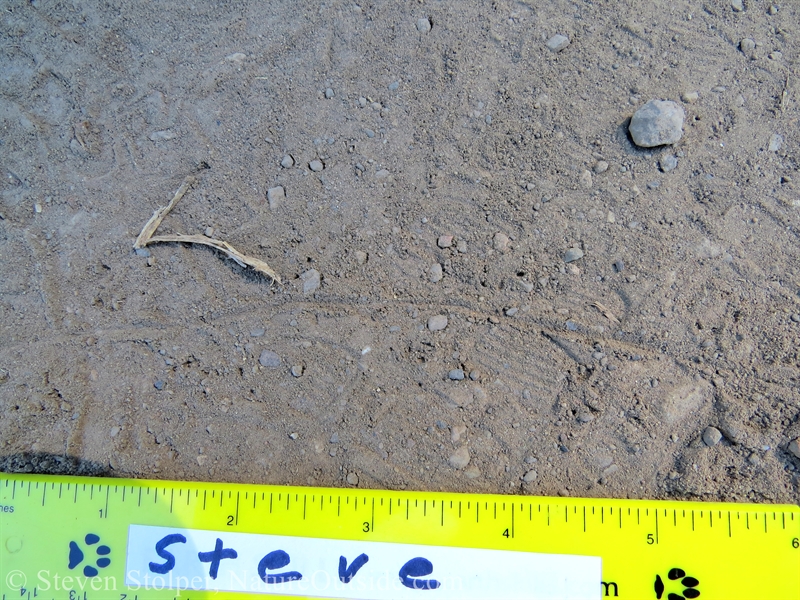
Keep an Eye Out
Once you can recognize reptile scata, you begin to notice it more often on your hikes. It can help you tell that a snake or lizard has been in the area.
Have you found lizard or snake scat? Let me know in the comments below.
References
Field Guide to Amphibians and Reptiles of California
Related Articles on NatureOutside
Mountain Kingsnake — Beauty and Danger!
For fun facts and useful tips, join the free Bushcraft Newsletter.



Hi Steven! Great article on Western Fence Lizards. We have a VERY similar fence lizard here in Mississippi that has many of the same features. Ours are found ONLY in the southern part of the state and rarely seen in urban areas. MOST Mississippians have never seen one! In contrast to the color-changing Anoles that seem to be everywhere.
Thanks for another GREAT read!
Tommy
Tommy, I’m glad you enjoyed the article! You sparked my curiosity about the Anole lizards in Mississippi. They look interesting and I’m going to learn more about them. Thanks!
Great day ! For several weeks I’ve been driving myself crazy trying to find the rat responsible for these singular white tipped 💩 ‘s i was finding in New spots each morning. Tracing &;documenting each 💩 like it were a Crime scene, placing baits, traps lethal & NON documenting any difference in baits size location everything. It finally Occurred to me only only minutes ago oh that it would be a toad toad then reading the article even possibly illusioneven possibly Elizabeth and it just makes perfect sense as well perfect sense as where I live there are a plethora of baby toads everywhere right now they’re so cute and they’re so small I’ve seen plenty of baby tree frogs but never so many baby toads they run more than they hop Sometimes I’ll put a little warm water in a pool on the ground and they will sit in it My landlord told me that those pills were from a bird and that’s what the white was now I totally understand it’s the egg egg component In the 2 species it gives us that Chelsea and depositI’m so glad I found this article because it totally relieves me because I have been obsessing over this thinking there was a rat destroying my house every night and I just could not find it or hear it. Now I realize I just need to put out a bunch of toad poison just kidding I wouldn’t ever do that… Great article again thank you
Thanks Steve, for this very informative article! I found some lizard scat in my SoCal backyard and though it might be rats. Now I know it’s from the Western Fence Lizards abundant around here. They are fascinating creatures. Thank you again!
You’re welcome, Coco! I’m glad you found the article helpful.
Same ! I have been completely obsessed with this 💩 thinking it were a rat. Putting down traps baits lethal and non, crawling all over under the house with a can of spray foam searching for the breach that I just knew must be somewhere imagining every sound were a den of rats just livin it up destroying my floors and walls roof 😳 just everything. What a relief this is off my mind
Wow! This was exactly what I was looking for! I had some unidentified poop just inside the door of my office (house converted to office) and I have seen western fence lizards escape from my approach, running as fast as they can and sliding under the door to the inside (crazy little fellas…it’s a house, not a rock). This morning I saw poop and was wondering, so I googled and found your article and your pictures. Mystery solved!
Case solved, Detective Sarah!
Thanks, Steve. I just saw the same poop in my backyard for the first time and thought small rodent. My wife beat me to the internet and said it was Western fence lizard, of which we have several. Now I’ll be looking for Stegner’s bench as I live in San Jose!
Steven, I’m glad you were able to identify your mystery pooper. Enjoy hiking to Stegner’s bench!
Great article! I found some poop in front of my door this am, but never seen it before, especially with the white cap. Was hoping it wasn’t some weird rat! I do have lizards that have been known to hang around by my door where it’s nice and cool, and since I live in the SoCal desert, probably a welcome treat for them! Was thinking caterpillar or garden worm, but way too big, and never before seen a white pellet with the black. Low and behold, your article! Thanks for solving my scat mystery!
RainyH, I’m glad you solved your scat mystery. It’s amazing how scat will tip you off to what animals are in the area and their behavior.
Thank you very much for your article. We had snakes living in the roof, and I found their scat in various places. After sealing off their entrance to the roof, I started finding what I thought was smaller snake scat in the garage, and I was getting very worried. It looks like the smaller snake scat was just from the lizards that the snakes have been eating.
I’m glad you were able to figure it out Sean. Now you don’t need to worry about baby snakes in the garage. 🙂
We live in the eastern Cascade foothills of Central Washington. After almost 30 years in our home with no lizards other than Blue Tail Skinks, we started seeing the occasional Fence Lizard. This year we are inundated with them, both large adult and tiny newborns. They are everywhere on our basalt rock walls. Larry the Lizard is a large adult who has taken up residence on our back patio. He has decimated the earwig population that usually decimates my wife’s plants. Now he follows us and watches for us to disturb earwigs, which he ambushes with lighting speed. We have even started feeding him budworms that we pick off of our blooms. Larry is quite gluttonous as he can eat 4 or 5 earwigs and a couple of fat budworms in a matter of minutes. As I write this, I can see him peeking out from under a planter outside the window, and yesterday he also took up watch from the corner of our wooden bench where he can survey all that moves in back of the house. He leaves his little white-tipped poops here and there, and they have now appeared on our bench. Considering his voracious appetite for earwigs, he is welcome to stay!
Doug, it sounds like you have a great new friend! It’s terrific that you can observe Larry up close and learn about his life.
I also have a pet lizard. I named him blu because I had never seen a western fence lizard before.
Jon, it’s cool that you have a pet lizard. You get to learn how they behave by watching what your pet does.
This year my common urban backyard near Sacramento California has seen an abundance of blue bellies. I put two and two together when I found this unusual scat everywhere. My new kitten has been delighted with so many lizards to chase (and bring in the house).
Dyana, it sounds like your yard is meeting their needs for shelter and food. Hopefully you enjoy them as much as your kitten.
How often do fence lizards poop? Eat? Drink?
I have one in my house and I feel badly for it. It won’t let me catch it to get it back outside, but there is no food or water for it inside.
Any tips for getting it outside if it won’t let me go near it?
Thanks.
Linda, there are no fixed answers about how often a particular lizard may eat or drink. I’ll send you Email and we can talk about how to get the lizard out of your house.
I live in Southern Indiana and we also have fence lizards with the blue bellies. I’m doing some remodeling and found the strange poop on top of my drop ceiling tiles. Immediately, I thought rats, then maybe a bird because of the white tips. It occurred to me that birds and reptiles are closely related and maybe they also had the white tipped scat. Thanks for your article it was the perfect answer to my mystery.
Great detective work, Chad! I’m glad you solved your mystery.
Hi Steve,
I discovered a “lizard poo mimic moth”. Would you be surprised that there’s a moth which has evolved to look like something a fence lizard won’t eat? ;^)
To see an image, just Google it.
I’ll take a look for the “lizard poo mimic moth!”
Steve,
Love your article and love these little guys, they’re all over my yard! I’m curious, they have such a strange little mechanism that delivers the poop out of their bodies and then retracts back in when finished. What more can you tell me about their pooping process? Watching it was both fascinating and a bit terrifying.
Tina, I’m glad you enjoyed the article. Lizards poop from an organ called a cloaca. It’s a common outlet for the intestines, urinary tract, and genitals. Reptiles, amphibians, birds, and sharks all have a cloaca. Mammals that are monotremes, like the platypus also have a cloaca.
I have never seen a lizard defecate. So you have more expertise in this area than I do! 🙂
I catch my Western Fence Lizards eating my dogs poop all the time. I also find their scat nearby a pile of dog poop. I’ve never seen this before this year and never seen so much scat before this year, but the lizards have lived here for 30 years. Many generations. I even know where they lay their eggs. This is new behavior to see so much scat on concrete. And catching them munching on something other than crickets is odd, too.
Wow, Susan, that is odd! Perhaps they are eating insects that are feeding on the dog poop? I’ll keep an eye out for this in the future.
Hello Steve,
A Google search brought me to your very informative article. As Linda posted on 10/18/20, I also found a lizard in my house a couple weeks ago. I tried to catch it by trying to place a thick bath towel over it in order to release it back outside. Bad idea, as all that did was have it take off running under the sofa. I have looked with a flashlight underneath the sofa as well as all the other furniture, beds, etc. but still have not been able to locate the lizard anywhere. I then assumed that it left through the same way it was able to enter. However, just this morning I found a piece of scat on the floor very close to the sofa that the lizard originally ran under. My question is how long can it live in my home with no food or water? Also, how can I find where it’s hiding so that I can release it back outside? By the way, I have lived in this house for 22 years and this is the first time this has ever happened. Thanks for any help you can offer me.
Nadine, lizards’ metabolism is less demanding than mammals, so it could live under your sofa for quite a while. I don’t have a good solution for how to catch it, other than to move the sofa and have helpers ready with Tupperware or boxes. If you see the lizard walk toward it slowly. If the lizard starts to move, stop and stay still for a second until it calms down. You can also use a broom to usher it toward the box. Once the lizard is in the box, cover it with cardboard or slide a piece of paper between the box and the floor (if the box is covering the lizard).
An alternate method may be removable tape on the bathroom floor, as he probably drinks the perspiration from the water inlet.
If he gets stuck on the removable tape (attached to a piece of cardboard) it will not hurt him, but rather slow him down enough for you to catch him up and place back outdoors.
Sadly as part of entomologist licensing we had to leave a glue board out to catch bugs at night and then identify next day in class. Some caught the lizards chasing the bugs 😔
Still, removable tape I think is called “magic tape” should do the job and accomplish the goal.
The other idea comes to mind is feeding him, maybe put some larvae down in a glass dish, he will begin going back to it nightly when all is calm, just put closer and closer to the door each night and eventually you can usher him out the same way
I’ve been observing a pair of side-blotched lizards from my porch in Tucson, AZ. I noticed a tiny scat on a rock within their regular territory – about the size of a piece of rice, on end, with the little white blob on top (maybe the white part comes out after the dark?). I’m hoping it’s a mating pair and that I see some young soon. But If they don’t procreate, that’s okay too. I have a picture but it looks like we can’t put pictures in the comments.
Anyways, take care
Jesse
That’s great, Jesse! Side-blotched lizards don’t live in my area of California. So I have never seen one before. I wish you luck starting your “lizard family!” 🙂
WOW, finally an explanation of the Lizard poop! I have been watching my various lizards for decades in the back yard and consider them my little pets as we have no ‘animal’ pets and they have free reign over the yard. The wall lizards are the most active and just yesterday I observed one on the edge of my step with his ass in the air and he dropped the URIC white chunk and then a huge poop. I have witnessed this before. But the best part was watching him actually wipe his butt on the edge of the step after the deal was done! most amusing. That was a first!
We have even ‘invented’ Lizard Ladders to try and give them an escape from drowning in the swimming pool, which they have done many times and it’s always a huge bummer to have to get their bodies out. BUT! I have also saved a lot of them by being aware and once even gave the Alligator Lizard emergency treatment and got him to start breathing again! My greatest SAVE of all.
Great information and fun reading on this blog. Thanks so much
Unfortunately the lizard ladders are not as effective as hoped as most of the time the lizards suffer from hypothermia when in the pool (winder for sure) and are dumb enough not to swim along the side at all to discover a netting that will allow them to escape. Just saved one 2 days ago. Of course hard to tell if the ladders are at all successful, but we have had a noticeable drop in drownings so far this year.
I have some great mating photos of the Alligator lizards too.
Chris, I think your lizard ladder idea is clever. I wonder if it’s worth attaching a small floating area to the the lizard ladder so the lizards will climb out of the water onto it, and then follow the ladder to safety. Keep up the good work!
I live in the Willow Glen district of San Jose. I’ve been here for 32 years, and have seldom seen a lizard in the yard, but during the last couple of years, it seems like there is a lizard darting out of my way every time I walk outside. After being in the house for about 45 minutes, I noticed something dark zipping by when I entered the kitchen. It was a little 3/4″-1″ fence lizard that probably came into the house same time I did. I managed to steer it back out the front door. I looked around for droppings, but couldn’t find any. Is there any reason to be concerned about E. coli or salmonella, if there are no droppings?
Jim, this is a good question. As long as you don’t handle the lizards themselves or their droppings, you should not need to worry about salmonella. If you do hold a lizard (maybe to “escort” them outside your home) or clean up droppings, then wash your hands thoroughly with soap and water. If you wash your hands before touching your mouth or food, you should be safe.